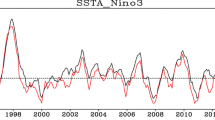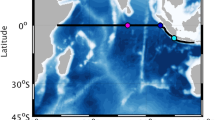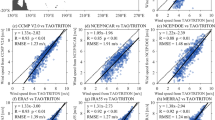Abstract
Variability of the Equatorial Indian Ocean (EIO) winds play crucial roles in driving the upper EIO dynamics and modifying the ocean–atmosphere interactions in the Indian Ocean (IO). This study, using a satellite-sensed high-resolution (0.25° × 0.25°) monthly winds, has revealed many salient features of the seasonal and inter-annual variability of winds at various dynamically significant regions of the EIO. Though annual mean wind pattern of the EIO shows westerlies east of 60°E, the different local areas in this ocean exhibit significant seasonal wind variations. Migrations and fluctuations of southerlies and westerlies primarily determine the EIO wind variability. In the western (eastern) EIO, SW and NE monsoon winds are stronger (weaker) and of longer (shorter) duration. Near to the equator (1°S–1°N), in the central EIO, weaker winds occur during SW and NE monsoons, whereas stronger winds during transition periods. Near the equator, meridional winds show a significant annual period, especially in the western EIO. But zonal winds exhibit semi-annual period east of 55°E with a peak in the central ocean associated with the active westerlies during spring and fall, and annual period west of 55°E in the western EIO due to monsoon reversals. Westerlies are stronger during the fall compared to spring. Zonal wind variability in the central EIO is the essential deciding factor for the zonal wind variability occurring in the whole EIO. Both Zonal Sea Level Pressure Gradient (ZSLPG) and Momentum Advection (MA) fields determine the dynamics of zonal winds in the EIO. Zonal winds are weak in the western EIO because of the semi-annual harmonics of both ZSLPG and MA, though with substantial amplitude, exhibiting opposite accelerations there. But stronger zonal winds occur in the central EIO (60°E–80°E) because of the same accelerations set by the relatively weaker ZSLPG and MA fields. The zonal winds show substantial inter-annual variability compared to the meridional winds. The inter-annual variability of zonal winds shows the predominance of two modes, with EOF1 50% and EOF2 20% of the total variance. Zonal wind pattern of EOF1 resembles the monsoon transition seasons, while that of EOF2 describes the SW monsoon. In the EIO, Indian Ocean Dipole (IOD) influences the patterns of winds and SST anomalies better than that of El Niño–Southern Oscillation (ENSO). Spatiotemporal variability of the EIO winds during ENSO and IOD indicates the prevalence of stronger zonal wind anomalies in the eastern and central EIO and weaker anomalies in the western EIO. Although spatial patterns of wind anomalies are similar during El Niño and Positive IOD (PIOD) periods, the monthly variations, spatial extensions, and intensities of anomalies are much different while comparing. Prospectus for understanding the EIO winds variations can help to understand the changes occurring in the wind-driven surface and subsurface zonal currents.













Similar content being viewed by others
References
Balmaseda MA, Mogensen K, Weaver AT (2013) Evaluation of the ECMWF ocean reanalysis system ORAS4. Q J R Meteol Soc 139(674):1132–1161
Chakraborty A, Nanjundiah RS, Srinivasan J (2009) Impact of African orography and the Indian summer monsoon on the low-level Somali jet. Int J Climatol 29(7):983–992
Chen G, Han W, Li Y, Wang D, McPhaden MJ (2015) Seasonal-to-Interannual time-scale dynamics of the Equatorial Undercurrent in the Indian Ocean. J Phys Oceanogr 45(6):1532–1553
Chen G, Han W, Li Y, Wang D (2016) Interannual variability of equatorial eastern Indian ocean upwelling: local versus remote forcing. J Phys Oceanogr 46(3):789–807. https://doi.org/10.1175/JPO-D-15-0117.1
Clarke AJ, Liu X (1993) Observations and dynamics of semiannual and annual sea levels near the eastern equatorial Indian ocean boundary. J Phys Oceanogr 23(2):386–399
Findlater J (1969) A major low-level air current near the Indian Ocean during the northern summer. Q J R Meteorol Soc 95:362–380
Francis PA, Gadgil S (2009) The aberrant behavior of the Indian monsoon in June 2009. Curr Sci 97(9):1291–1295
Freilich M (2000) SeaWinds: algorithm theoretical basis document. NASA ATBD-SWS-01
Gadgil S, Vinayachandran PN, Francis PA (2004) Extremes of the Indian summer monsoon rainfall, ENSO and the equatorial Indian Ocean Oscillation. Geophys Res Lett 31:L12213. https://doi.org/10.1029/2004GL019733
Gill AE (1980) Some simple solutions for heat-induced tropical circulation. Q J R Meteol Soc 106(449):447–462. https://doi.org/10.1002/qj.49710644905
Gnanaseelan C, Deshpande A, McPhaden MJ (2012) Impact of Indian Ocean dipole and El Niño/Southern Oscillation wind-forcing on the Wyrtki jets. J Geophys Res 117:C08005. https://doi.org/10.1029/2012JC007918
Han W, Webster PJ (2002) Forcing mechanisms of sea level interannual variability in the Bay of Bengal. J Phys Oceanogr 32(1):216–239
Hastenrath S, Nicklis A, Greischar L (1993) Atmospheric-hydrospheric mechanisms of climate anomalies in the western equatorial Indian Ocean. J Geophys Res 98:20219. https://doi.org/10.1029/93JC02330
Hastenrath S, Polzin D (2004) Dynamics of the surface wind field over the equatorial Indian Ocean. Quat J R Meteo Soc 130(597):503–517. https://doi.org/10.1256/qj.03.79
Huang B, Kinter JL III (2002) Interannual variability in the tropical Indian Ocean. J Geophys Res 107:3199. https://doi.org/10.1029/2001JC001278
Iskandar I, Mardiansyah W, Masumoto Y, Yamagata T (2005) Intraseasonal Kelvin waves along the southern coast of Sumatra and Java. J Geophys Res Ocean 110(4):1–12. https://doi.org/10.1029/2004JC002508
Iskandar I, Masumoto Y, Mizuno K (2009) Subsurface equatorial zonal current in the eastern Indian Ocean. J Geophys Res: Ocean 114(C06005):1–12. https://doi.org/10.1029/2008JC005118
Jakubasukas ME, Legates DR, Kastens JH (2001) Harmonic analysis of time-series AVHRR NDVI data. Photogramm Eng Remote Sens 67:461–470
Jenkins GM, Watts DG (1968) Spectral analysis and its applications (5th printing of the 1968 edition). Holden-Day, San Francisco, p 525
Knox RA (1976) On a long series of measurements of Indian Ocean equatorial currents near Addu Atoll. Deep-Sea Res Oceanogr Abstr. https://doi.org/10.1016/0011-7471(76)91325-5
Krishnamurti TN, Molinari J, Pan HL (1976) Numerical simulation of the Somali Jet. J Atmos Sci 33:2350–2362
Lindzen RS, Nigam S (1987) On the role of sea surface temperature gradients in forcing low-level winds and convergence in the tropics. J Atmos Sci 44:2418–2436
Lungu T (2001) QuikSCAT Science data product user's manual, version 2.2, JPL document D-18053. Jet Propulsion Laboratory, Pasadena
McCreary JP, Kundu PK, Molinari RL (1993) A numerical investigation of dynamics, thermodynamics and mixed-layer processes in the Indian Ocean. Prog Oceanogr. https://doi.org/10.1016/0079-6611(93)90002-U
McCreary JP, Han W, Shankar D, Shetye SR (1996) Dynamics of the East India coastal current: 2 numerical solutions. J Geophys Res 101:13993–14010
Murtugudde R, Busalachi A (1999) Interannual variability of the dynamics and thermodynamics of the tropical Indian Ocean. J Clim 12:2300–2326
National Geophysical Data Center (2006) 2-minute gridded global relief data (ETOPO2) v2. Natl Geophys Data Center NOAA. https://doi.org/10.7289/V5J1012Q
Okumura Y, Xie SP (2004) Interaction of the Atlantic equatorial cold tongue and African monsoon. J Clim 17:3588–3601
Onogi K, Tsutsui J, Koide H, Sakamoto M, Kobayashi S, Hatsushika H, Matsumoto T, Yamazaki N, Kamahori H, Takahashi K, Kadokura S (2007) The JRA-25 reanalysis. J Meteol Soc Jpn Ser II 85(3):369–432
Potemra JT, Luther ME, O’Brien JJ (1991) The seasonal circulation of the upper ocean in the Bay of Bengal. J Geophys Res 96(91):12667–12683. https://doi.org/10.1029/91JC01045
Rao RR, Girish Kumar MS, Ravichandran M, Rao AR, Gopalakrishna VV, Thadathil P (2010) Interannual variability of Kelvin wave propagation in the wave guides of the equatorial Indian Ocean, the coastal Bay of Bengal and the Southeastern Arabian Sea during 1993–2006. Deep Sea Res Part 1(57):1–13
Reynolds RW, Rayner NA, Smith TM, Stokes DC, Wang W (2002) An improved in situ and satellite SST analysis for climate. J Clim 15(13):1609–1625. https://doi.org/10.1175/1520-0442(2002)0151609:AIISAS2.0.CO;2
Saji NH, Goswami BN, Vinayachandran PN, Yamagata T (1999) A dipole mode in the tropical Indian Ocean. Nature 401(6751):360
Schott FA, Dengler M, Schoenefeldt R (2002) The shallow overturning circulation of the Indian Ocean. Prog Oceanogr 53(1):57–103. https://doi.org/10.1016/S0079-6611(02)00039-3
Schott FA, Xie SP, McCreary JP Jr (2009) Indian Ocean circulation and climate variability. Rev Geophys 47(2007):1–46. https://doi.org/10.1029/2007RG000245
Senan R, Sengupta D, Goswami BN (2003) Intraseasonal “monsoon jets” in the equatorial Indian Ocean. Geophys Res Lett 30(14):1–4. https://doi.org/10.1029/2003GL017583
Shaji C, Iizuka S, Matsuura T (2003) Seasonal variability of near-surface heat budget of selected oceanic areas in the North Tropical Indian Ocean. J Oceanogr 59(1):87–103. https://doi.org/10.1023/A:1022872524758
Shankar D, Vinayachandran PN, Unnikrishnan AS (2002) The monsoon currents in the north Indian Ocean. Prog Oceanogr 52(1):63–120. https://doi.org/10.1016/S0079-6611(02)00024-1
Singer IA (1967) Steadiness of the wind. J Appl Meteorol 6(6):1033–1038
Tsai PTH, Obrien JJ, Luther ME (1992) The 26-day oscillation observed in the satellite sea-surface temperature-measurements in the Equatorial Western Indian-Ocean. J Geophys Res Oceans 97:9605–9618
Vinayachandran PN, Iizuka S, Yamagata T (2002) Indian Ocean dipole mode events in an ocean general circulation model. Deep Sea Res Part II Top Stud Oceanogr 49(7–8):1573–1596. https://doi.org/10.1016/S0967-0645(01)00157-6
Vinayachandran PN, Francis PA, Rao SA (2009) Indian Ocean dipole: processes and impacts. Current trends in science (Platinum Jubilee Special Publication). Indian Academy of Sciences, Sadashivanagar, pp 569–589
Webster PJ (1972) Response of the tropical atmosphere to local. Steady Forcing Mon Weather Rev 1000(7):518–541
Yamagata T, Mizuno K et al (1996) Seasonal variations in the equatorial Indian Ocean and their impact on the Lombok throughflow. J Geophys Res 101:12465–12474
Yu L, O’Brien JJ, Yang J (1991) On the remote forcing of the circulation in the Bay of Bengal. J Geophys Res 96(CII):20449–20454. https://doi.org/10.1029/91JC02424
Acknowledgements
This research work is a part of the two climate change-related research projects funded by the organizations CSIR-National Institute of Science Communication and Information Resources (CSIR-NISCAIR), New Delhi, and Department of Science and Technology, New Delhi. We also much appreciate the comments from anonymous reviewers, and the suggestions and encouragement from the Editor of the journal, which led to improving the article substantially.
Author information
Authors and Affiliations
Corresponding author
Additional information
Communicated by S. Trini Castelli.
Publisher's Note
Springer Nature remains neutral with regard to jurisdictional claims in published maps and institutional affiliations.
Rights and permissions
About this article
Cite this article
Shaji, C., Ruma, S. On the seasonal and inter-annual variability of the equatorial Indian Ocean surface winds. Meteorol Atmos Phys 132, 353–376 (2020). https://doi.org/10.1007/s00703-019-00690-9
Received:
Accepted:
Published:
Issue Date:
DOI: https://doi.org/10.1007/s00703-019-00690-9




